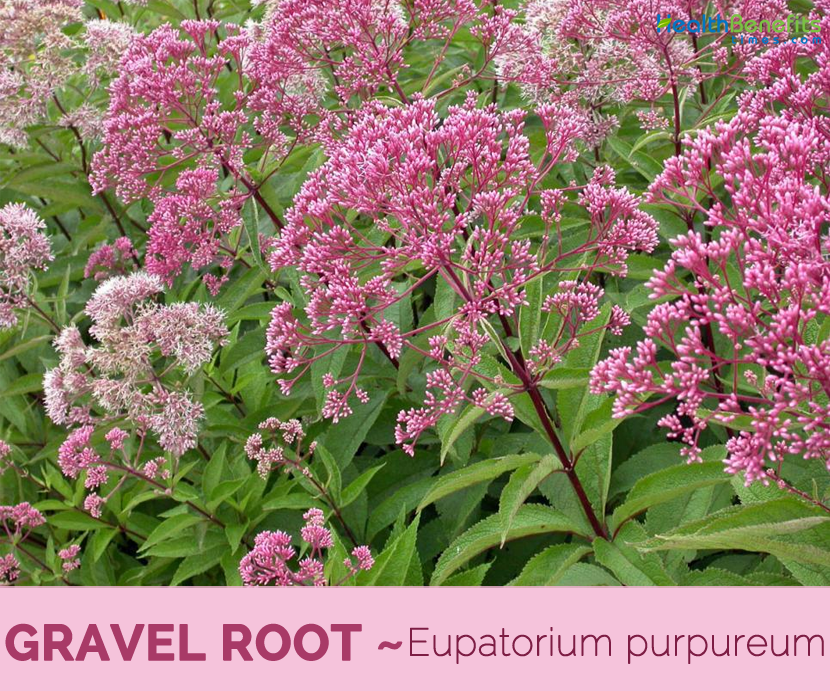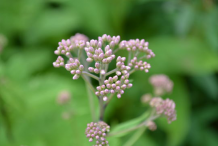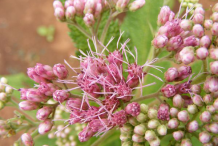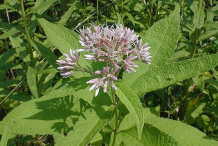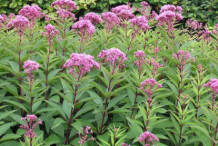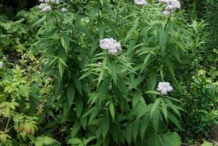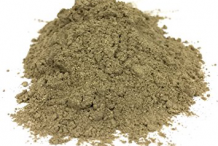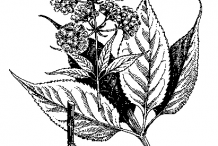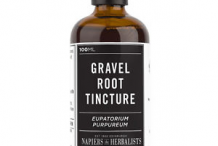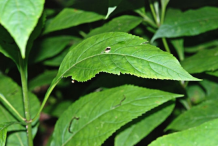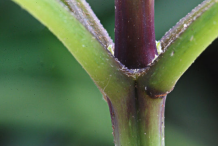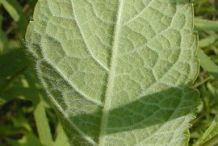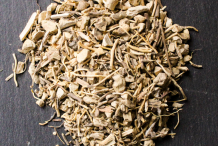Plant Description
Gravel Root is a large, herbaceous perennial plant that grows about 1.5 – 2.4 meters (5 – 8 feet) tall and about 1.2 meters (4 ft.) wide. The plant is found growing in open woodlands, savannas, woodland borders, thickets, partially shaded seeps, partially shaded riverbanks, low moist ground, wooded slopes, wet meadows and thickets and stream margins and prefers ordinary garden soil that is well-drained but moisture retentive. The plant has shallow and fibrous root system and upright, thick, round, and purple stem, with whorls of leaves at each node. Central stem is light green and glabrous, except where the whorls of leaves of occur, where it is slightly swollen and purple.
Leaves
Leaves are about 6 inch long and 3½ inch across or sometimes larger; they are broadly lanceolate or ovate and crenate-serrated along the margins. Each leaf is dull green and hairless on the upper surface; the lower surface is pale green and hairless to finely pubescent.
Flower & Fruit
Tiny, vanilla-scented, dull pinkish-purple flowers in large, terminal, domed, compound inflorescences bloom in mid-summer to early fall. Each flower cluster typically has 5-7 florets. Flowers are very attractive to butterflies. Flowers give way to attractive seed heads which persist well into winter. Each floret is replaced by a bullet-shaped achene with a small tuft of hair. These achenes are dispersed by the wind. Aerial parts, rhizome and Fresh root are used medicinally to cure several health ailments.
History
The common name of gravel root, Joe Pye Weed, is supposed to be the name of an Abenaki First Nation healer who saved the New England colonists from typhoid fever. Another probable source for its name the word ‘jopi,’ and apparently First Nations Abenaki name for typhoid fever and hence Jopiweed. Although it has been used as a mild diaphoretic its more commonly used name of Gravel root however provides a better indication of its more important traditional uses, to dispel small stones and sludge from the bladder. Cherokee nation used Gravel root in the treatment of joint disorders and urinary problems, and used the stem to suck water from shallow springs and to blow medicine into the nose. It has a smell resembling old hay, and a slightly bitter, aromatic taste, which is faintly astringent but not unpleasant. It yields its properties to water by decoction or spirits.
Popular Varieties to Grow
- Eupatorium purpureum ‘Gateway’ – Shorter variety (4-5’) with deep maroon stems
- Eupatorium purpureum ‘Little Joe’ – A dwarf version (3-4’) that looks very similar to the species
- Eupatorium rugosum ‘Chocolate’ – A close relative with dark leaves, maroon stems and white flowers
Health benefits of Gravel root
Whole plant, particularly the root, is astringent, diuretic, nervine and tonic. It works mostly on the genito-urinary system and the uterus. It is valuable as a diuretic and stimulant, as well as an astringent tonic; a tea made from the roots and leaves has been used to eliminate stones from the urinary tract, to treat urinary incontinence in children, cystitis, urethritis, impotence etc. Listed below are few of the popular health benefits of Gravel root
1. Beneficial for Kidney Stones
Gravel root derives its name for its ability to break down stones in the kidneys and other organs of the body. Native Americans traditionally used it for this reason believing that it could soften and dissolve kidney stones and promote their easy passage through the system. Despite this traditional use, there is no modern scientific proof available to confirm that it works and the only real evidence is anecdotal.
2. Good for Gout and Arthritis
Gout is an extremely painful condition that is caused when an excess of uric acid build up in the joints. It can affect the joints in the entire body but is more typical in the feet particularly the big toe. Traditionally gravel root has been used to cleanse the kidney and dissolve the build-up of uric acid though again.
There is no evidence that it works beyond the anecdotal. That is not to say that it is not very effective and despite the lack of research, we can learn a lot from a long history of usage. As well as being used to relieve gout, gravel root has also been used for rheumatism and arthritis.
3. Cures Urinary Tract Infections
Gravel root has famously been used for centuries to treat bladder infections and other conditions affecting the urinary tract. It has excellent natural diuretic abilities and a soothing, astringent effect on the urinary tract.
4. Good for Gallstones
Gallstones are a common complaint affecting the gallbladder. They are not actually stones but hardened deposits which can gather in your digestive fluid. These crystalline deposits differ in size from a grain of sand to much larger golf ball-sized stones.
There is no scientific evidence that it will work but traditionally, gravel root has been used to dissolve these stones in the same way that it has been used to ease the passage of kidney stones and to prevent them from reforming.
5. Beneficial for Dogs
Gravel root not only has potential benefits for humans but it might also be beneficial for your beloved pets. Dogs often suffer from kidney stones and according to online evidence you can use gravel root to treat your pets naturally.
Traditional uses and benefits of Gravel root
- Gravel root was used by the native N. American Indians as a diaphoretic to induce perspiration and break a fever.
- Whole plant, especially the root, is astringent, diuretic, nervine and tonic.
- It works on the genito-urinary system and the uterus.
- It is valuable as a diuretic and stimulant, as well as an astringent tonic.
- Tea made from the roots and leaves has been used to eliminate stones from the urinary tract, to treat urinary incontinence in children, cystitis, urethritis, impotence etc.
- It is said to be helpful in treating rheumatism and gout by increasing the removal of waste from the kidneys.
- Leaves and flowering stems are collected in the summer before the buds open and are dried for later use.
- It is considered a valuable cure in dropsy, strangury, gravel, hematuria, gout and rheumatism, exerting a special influence upon chronic renal and cystic troubles.
- It is used as a healing tonic included relieving constipation, washing wounds with a strong tea made from the root to prevent infection and as a general tonic taken during pregnancy and after childbirth.
- Its main use is to treat urinary infections and stones.
- Gravel root is also useful for cystitis, urethritis, prostate enlargement, and for rheumatism and gout.
- Tea of this herb is used to induce sweating and break a high fever.
- Gravel root can be used to alleviate problems with cystitis.
- Gravel Root is supposed to help women who experience difficult menstrual periods.
- Herb is said to encourage the flow of menstrual blood and regulate its flow, which helps to relieve two specific conditions, amenorrhea (the absence or suppression of menstruation) and dysmenorrhea (painful and difficult menstruation).
- Gravel Root is said to influence the entire nervous system, and its relaxant qualities are thought to be useful in relieving nervous conditions, migraines, headache, hysteria, hypochondria and flatulence.
- Gravel Root is also used to relieve the back pain that is frequently caused by kidney inflammation.
- It has been useful for the treatment of enuresis, which is helpful for children and incontinence in the elderly.
- It is also beneficial for treating urinary tract infections as it helps to flush out harmful bacteria from the urethra, the bladder, or the prostate gland.
Ayurvedic Health benefits of Gravel root
- Kidney Stones: Stones may be treated by administering a combo of stone root, Parsley piert, Gravel root, Parietaria judaica, Hydrangea.
- Kidney stones: Take equal amount of Hydrangea root, stone root, Bearberry and Gravel root. Powder them together. Have one tsp with lukewarm water once a day.
- Gallstones: Mix 3 parts of turmeric root with 2 parts of each parsley root, Eupatorium purpureum, common Marshmallow, Licorice, ginger and Dandelion. Make small tablets and take 2 tablets thrice a day. It is good for both kidney and bladder stones.
Gravel Root Kidney Stone Formula
Ingredients
- 1 part gravel root
- 1 part corn silk
- 1 part wild yam
- 1 part cramp bark
- 1 part hydrangea root
- 100 proof spirits such as vodka
Instructions
- Combine all dry ingredients. Place in a jar with a tight fighting lid and cover with 5 parts alcohol. Ex: if the total weight of your dried herbs is equal to 5 ounces, combine with 25 ounces alcohol.
- Infuse the herbs into the alcohol for at least 6 weeks, shaking daily. When done, strain through layers of cheesecloth or muslin, into amber dropper bottles.
- Standard adult dose: 5mls, up to 3x daily for preventative actions or 5mls up to 3x daily for acute complaints.
Precautions
- It may cause Allergic reaction.
- Avoid use by pregnant and breast feeding women.
- Several side effects including stomach pain, nausea and liver problems are noticed when it is taken in excess.
- It is certainly best to avoid using gravel root if you are suffering from a pre-existing liver complaint.
- Do not apply to broken or abraded skin.
- Not to be used for more than 28 days per year on account of the pyrollizidine alkaloid content.
References:
https://www.gbif.org/species/5401611
http://www.plantnames.unimelb.edu.au/Sorting/Eupatorium.html
https://www.itis.gov/servlet/SingleRpt/SingleRpt?search_topic=TSN&search_value=780334#null
http://davesgarden.com/guides/pf/go/11/
http://pfaf.org/user/Plant.aspx?LatinName=Eupatorium+purpureum
http://www.missouribotanicalgarden.org/PlantFinder/PlantFinderDetails.aspx?kempercode=c740
https://www.nps.gov/plants/pubs/chesapeake/plant/1169.htm
http://www.botanical.com/botanical/mgmh/g/gravel35.html
https://plants.usda.gov/core/profile?symbol=eupu21
http://www.herbco.com/c-353-gravel-root.aspx
https://healthyfocus.org/gravel-root-benefits/
https://en.wikipedia.org/wiki/Eutrochium_purpureum
https://nutrawiki.org/eupatorium-purpureum/
Comments
| Gravel root Quick Facts | |
|---|---|
| Name: | Gravel root |
| Scientific Name: | Eupatorium purpureum |
| Origin | Northwest, eastern and central North America |
| Shapes | Bullet-shaped achene with a small tuft of hair |
| Taste | Aromatic, astringent, and bitter |
| Health benefits | Beneficial for Kidney Stones and Good for Gout and Arthritis |
| Name | Gravel Root |
|---|---|
| Scientific Name | Eupatorium purpureum |
| Native | Northwest, eastern and central North America |
| Common Names | Sweet Joe-Pye Weed, kidney-root, sweet scented joe-pie weed, gravel root, or trumpet weed |
| Name in Other Languages | Dutch: Purper Lieverkruid English: Gravelroot, Green-stemmed joe-pye-weed, Joe-pye, Joe-pye weed, Marsh-milkweed , Purple Joe-pye-weed, Purple Boneset, Queen-of-the-meadow, Sweet joe-pye-weed, bluestem, sweetscented joepyeweed, trumpet weed, gravel weed, Jopi weed, Finnish: Purppurapunalatva French: Eupatoire pourpre, Eupatoire d’eau à tiges rouges, Euparoire rouge, Herbe à la gravelle, Racine à la gravelle. German: Purpur-Wasserdost. Russian: Poskonnik purpurnyi (Посконник пурпурный) |
| Plant Growth Habit | Large, herbaceous perennial plant |
| Growing Climate | Open woodlands, savannas, woodland borders, thickets, partially shaded seeps, partially shaded riverbanks, low moist ground, wooded slopes, wet meadows and thickets and stream margins |
| Soil | Grows in ordinary garden soil that is well-drained but moisture retentive. |
| Plant Size | 1.5 – 2.4 meters (5 – 8 feet) tall and about 1.2 meters (4 ft.) wide. |
| Root | Shallow and fibrous |
| Stem | Upright, thick, round, and purple, with whorls of leaves at each node. Central stem is light green and glabrous, except where the whorls of leaves of occur, where it is slightly swollen and purple |
| Leaf | About 6 inch long and 3½ inch across or sometimes larger; they are broadly lanceolate or ovate and crenate-serrated along the margins. Each leaf is dull green and hairless on the upper surface; the lower surface is pale green and hairless to finely pubescent. |
| Flowering Periods | Aug to October |
| Flower | Tiny, vanilla-scented, dull pinkish-purple flowers in large, terminal, domed, compound inflorescences bloom in mid-summer to early fall. |
| Fruit | Bullet-shaped achene with a small tuft of hair |
| Taste | Aromatic, astringent, and bitter |
| Plant Parts Used | Aerial parts, rhizome and Fresh root |
| Available Forms | Tea, tincture and capsule form |
| Season | Sep to November |
| Popular Varieties |
|
| Health Benefits |
|
| How to Eat |
|
| Other Facts |
|


